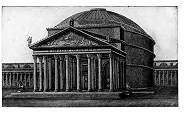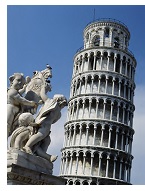|
Rome Sights to See - The Pantheon
|
Of all the sights to see around the world, few ancient buildings have
survived the ravages of time so well as the Pantheon in Rome. It is the
only example of similar age, size and span that still remains intact.
This is no accident! In actuality, it's largely the
result of superior engineering and design.
 Often copied, sometimes equaled (or nearly equaled) but never actually
surpassed, it had more architectural innovations than most modern
buildings. This is all the more remarkable, given that the Pantheon was
built around 125 AD under the aegis of the emperor Hadrian. Often copied, sometimes equaled (or nearly equaled) but never actually
surpassed, it had more architectural innovations than most modern
buildings. This is all the more remarkable, given that the Pantheon was
built around 125 AD under the aegis of the emperor Hadrian.
The plan of the Pantheon is simple enough. It is just a
circular enclosure aside a rectangular entrance. The entrance sports a
classic Greek portico of granite columns topped by a triangular pediment. There are
three ranks of the 39 ft Corinthian
supports. There are eight in front and two sets of four
further in leading to the main rotunda. A rectangular section joins the
portico to the rotunda.
However, it is what is found within that simple design which holds several marks of genius.
The giant concrete dome topping the cylinder forming the major
component was so well designed and built that no similar type would be
able stand up under its own weight.
The dome is 142 feet in diameter (46 feet larger than that which crowns
the White House in Washington, DC), while the oculus (a circular
window) at the peak is over 25 feet of that total. It stands as a
result of its unusual composition, outstanding engineering and
brilliant construction.
Just one example of that engineering genius is that very oculus in the
center - the circular window at the top of the dome. It not only
decreases the overall weight, but also serves as a ring that
distributes stress around its circumference. Imagine, by analogy, how
difficult it is to crush a bicycle wheel.
It also serves as a skylignt which admits light to the
interior...and rain, too it must be said. Even this was
anticipated, however, as the floor is an early example of slanting the
floor toward drains.
The dome's tapering steps provide yet more evidence of the mastery of
craft displayed by the dome's bygone designer.
It's 20 feet thick at the base, 7.5 at the oculus and composed of
heavier material at the bottom, lighter as it rises. That doesn't seem
so remarkable until one considers that many architects a thousand years
later often ignored this simple idea.
Nearly two thousand years after its creation, the Pantheon in Rome is
as stable today as when it was first built. Yet, like so many other
ancient marvels, it was constructed without the benefit of computers,
machines, engineering knowledge, or modern tools.
Nor did the designers and engineers of the Pantheon have the
advantage of modern transportation methods. All the materials for its construction were
floated down the Tiber and moved to the site by man and animal on carts of the period.
Though the enormous bronze doors have been restored many times, no
major structural work has ever had to be undertaken on it. This is all
the more remarkable given the marshy land on which the structure is built.
By contrast, observe that there have been several decades-long projects
to preserve the Leaning
Tower of Pisa, owing in part to the soft ground in
parts of the site. The Parthenon
in Greece, though a great building in its own right,
was a virtual ruin 2,000 years after its birth. owing in part to the soft ground in
parts of the site. The Parthenon
in Greece, though a great building in its own right,
was a virtual ruin 2,000 years after its birth.
The Pantheon in Rome was first converted to a church during the 8th
century and continues to serve that purpose today. In fact, the
building has been in continuous use since first being built.
This amazing building has often been copied. Two notable
examples of this being the British Museum
Reading Room in London, and the Thomas Jefferson Rotunda
at the University of Virginia.
When seeing all that there is to see in Rome, be sure to spend time
viewing the original Pantheon.
Rome
the Eternal City
Sitemap
Travel
|

